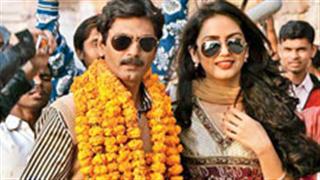Hipsterism, with self-conscious irony, is an urban, elite niche in India, that wonderland of in your face, loudspeaker-blaring, exhibitionist earnestness. Most hipsters in entertainment tone down their hipsterism - MTV, for example. But Sneha Khanwalkar is a unicorn, a crossover hipster who has defined a brand new niche.
The songs in Gangs of Wasseypur I and II are shape-shifting in context. Deliberately so - a hipster would treat most of them as tongue-in-cheek, but a conventional audience will take them at face value. No doubt Khanwalkar, who cleaves to the artistic credo of universality, is cool with that. Besides, the universal appeal fits in with the hipster sensibility, which delights in irony.

The song 'Kaala re' from Gangs of Wasseypur II is a hybrid of a married woman's folksy lament with a modern, bluesy treatment. The protagonist of the song is a disenfranchised woman without any say in her marital life, and she is saddened by her man's black-marketing of black coal.
The song is her voice, wistful for a hope of normalcy, as she floats to a state of resignation. It is minimally arranged with electronic music influences and fateful-sounding folksy drumming. You might call this song Indi-Blues.
Then there is laugh-out-loud satire in the laterally thought-out 'Electric Piya', a bridal song where the newlywed bride complains to her in-laws about the thinness of her man. 'Taar bijlee se patle hamare piya/ saasu tune yeh kya kiya.' This is along traditional lines. But wait, the singer of the bridal song
then complains to the local politicians! Not coincidentally, the lyricist Varun Grover is a successful humorist and stand-up comic.

If these songs show a tender human sensitivity with a hip appeal, 'Hunter' from GOW 1, is a wink at Indian macho. Consider these lyrics - 'I am a hunter/ she want to see me gun/ when I pull it out/ boy, the woman start to run.' Read 'dick' for 'gun'.
A politically incorrect song that a certain audience might take literally, and another will smile at, tongue-in-cheek. 'Hunter' is chameleonic - intended to shift in context depending on the audience.
The shape-shifting is also apparent in 'Chi cha leather', slang for 'in trouble' (from GOW II). Evidently the protagonist of the song is in difficulties. He is running from a violent mess, and the song deals with his predicament. The song builds him up and then lets him down with a thud of pathos.
The power of the song comes from the raw voice of the twelve-year-old amateur singer, and the fact that the song is minimally arranged so her vocals carry the edgy mood, and the feats of kitsch as 'Mera joota fake leather/ dil chi cha leather/ wo pucche hamse/ whether I like the weather'. The lyrics are incomplete, the song is deliberately elliptical, yet a mood of menace and irony is successfully evoked by the whole package.

Part of the hipster sensibility is to absorb multiple cultures and remix them. The calling card of 'O Womaniya', for example, is its nod to India's evolving hybrid dialects - what you would call Bhojlish, English words mating with Bhojpuri ones, or where modern social concepts, contexts and sensibilities fecundate the regional language.
On its surface, the rustic and folksy 'O Womaniya' is about the coyness of a girl whose lover is trying to get intimate with her. Are girls coy in this day and age? Even girls in small towns? The 'Womaniya' in the song is not as coy as she appears, the fact is that she fears social taboos.
Two people who know this are Khanwalkar and Grover, with the consequence that the hinterland audience will recognise the coy folksy touch, and yet identify the song as tongue-in-cheek.
Take the tongue away from the cheek, though, for 'Keh ke Lunga', which is, of course, the theme song of GOW. The theme is revenge, celebration of revenge, revenge masturbating narcissistically.
Appropriately, the vocals, that end in her high-pitched note, evoke an anguished, orgasmic shriek. 'Keh Ke' captures the feeling of joyous revengefulness perfectly. Why joyous? Because revenge gives you an objective and focuses you. Like the other tracks, 'Keh ke Lunga' is an exploration of a facet of the collective Indian psyche, where violence, repressed, lurks, bides its time.

For perhaps the first time in India, GOW 1 and 2 is music for the elite hipster and others. Through its multicultural references, consequent universality, and multi-classness, the music of GOW 1 and 2 rewrites the definition of cool. It brings folksiness and roots into the ambit of cool, and democratises it, and that can only be a good thing




















